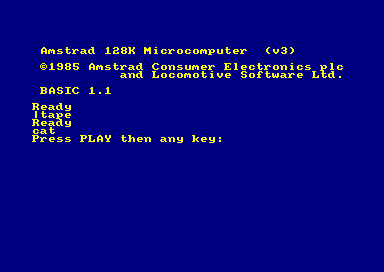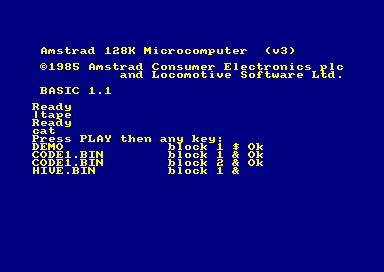(New page: '''Testing tips''' If the program uses standard block loading then you can test the image is correct in the following way: * Start the Amstrad emulator, * Insert the tape-image to test...) |
|||
| (3 intermediate revisions by 2 users not shown) | |||
| Line 1: | Line 1: | ||
| − | ''' | + | [[Category:Cpctech.org]] |
| + | |||
| + | <div style="border: 1px solid rgb(228, 222, 222); margin: 0px 0px 5px; padding: 0.5em 1em; background-color: rgb(249, 249, 249);"> | ||
| + | <center> | ||
| + | |||
| + | '''''This article originally came from Kevin Thackers' archive at [http://www.cpctech.org.uk http://www.cpctech.org.uk].''''' </center></div> | ||
If the program uses standard block loading then you can test the image is correct in the following way: | If the program uses standard block loading then you can test the image is correct in the following way: | ||
| Line 6: | Line 11: | ||
* Insert the tape-image to test, | * Insert the tape-image to test, | ||
* Reset the CPC | * Reset the CPC | ||
| − | * At the "Ready" prompt type: <br/> |TAPE:CAT | + | * At the "Ready" prompt type: <br/> <pre>|TAPE:CAT</pre> |
| − | * The following message will then be displayed: <br/> Press PLAY then any key<br/> [[Image:cat1.png]] | + | * The following message will then be displayed: <br/> <pre>Press PLAY then any key</pre><br/> |
| − | * Press a key, and then wait. After some time you will see a message similar to this: <br/> <nowiki><filename> </nowiki> <nowiki>block <block number> <file type symbol></nowiki><br/> Where: | + | |
| + | [[Image:cat1.png]] | ||
| + | |||
| + | |||
| + | * Press a key, and then wait. After some time you will see a message similar to this: <br/> | ||
| + | <pre><nowiki><filename> </nowiki> <nowiki>block <block number> <file type symbol></nowiki></pre><br/> Where: | ||
** <nowiki><filename> is the name of the file on the cassette (maximum of 16 characters) </nowiki> | ** <nowiki><filename> is the name of the file on the cassette (maximum of 16 characters) </nowiki> | ||
** <nowiki><block number> is the number of the current block being tested, </nowiki> | ** <nowiki><block number> is the number of the current block being tested, </nowiki> | ||
| Line 15: | Line 25: | ||
{| class="prettytable" | {| class="prettytable" | ||
| − | ! | + | ! Symbol |
| − | ! | + | ! File type |
|- | |- | ||
| − | | $ | + | |$ |
| Unprotected BASIC file | | Unprotected BASIC file | ||
|- | |- | ||
| − | | % | + | |% |
| protected BASIC file (the program can't be listed) | | protected BASIC file (the program can't be listed) | ||
|- | |- | ||
| − | | & | + | |& |
| Unprotected binary file | | Unprotected binary file | ||
|- | |- | ||
| − | | ' | + | |' |
| Protected binary file | | Protected binary file | ||
|} | |} | ||
| + | |||
[[Image:cat2.png]] | [[Image:cat2.png]] | ||
An example is: | An example is: | ||
| − | + | <pre>HUDSON HAWK block 1 &</pre> | |
If the block is correct and the CRC checksum is valid, then "Ok" will be printed after the file type symbol. e.g. | If the block is correct and the CRC checksum is valid, then "Ok" will be printed after the file type symbol. e.g. | ||
| − | + | <pre>HUDSON HAWK block 1 & Ok</pre> | |
If there is an error "Read error a" or "Read error b" will be displayed. | If there is an error "Read error a" or "Read error b" will be displayed. | ||
| Line 51: | Line 62: | ||
** It is ideal for testing programs that only use the standard loader, but may contain many parts that are not loaded immediatly. e.g. a multi-loader program, many seperate programs on the same cassette | ** It is ideal for testing programs that only use the standard loader, but may contain many parts that are not loaded immediatly. e.g. a multi-loader program, many seperate programs on the same cassette | ||
** Some programs disable the cassette messages (e.g. messages like "Loading HUDSON HAWK block 1"), and it is not easy to identify the name or number of a bad block. With this method, the name and block numbers are listed. | ** Some programs disable the cassette messages (e.g. messages like "Loading HUDSON HAWK block 1"), and it is not easy to identify the name or number of a bad block. With this method, the name and block numbers are listed. | ||
| − | ** You can easily identify blocks that are missing (maybe they were not decoded by voc2tzx). e.g. <br/> | + | ** You can easily identify blocks that are missing (maybe they were not decoded by voc2tzx). e.g. <br/> |
| + | <pre> | ||
| + | HUDSON HAWK block 1 & Ok | ||
| + | HUDSON HAWK block 3 & Ok | ||
| + | </pre> | ||
| + | <br/> In this example, block 2 of "HUDSON HAWK" is missing. This would result in a "Rewind tape" error. | ||
** You can compare the list of blocks against the graphical display of the sound wave in a sound editor and identify any blocks that are not correct. | ** You can compare the list of blocks against the graphical display of the sound wave in a sound editor and identify any blocks that are not correct. | ||
Latest revision as of 16:33, 17 December 2010
If the program uses standard block loading then you can test the image is correct in the following way:
- Start the Amstrad emulator,
- Insert the tape-image to test,
- Reset the CPC
- At the "Ready" prompt type:
|TAPE:CAT
- The following message will then be displayed:
Press PLAY then any key
- Press a key, and then wait. After some time you will see a message similar to this:
<filename> block <block number> <file type symbol>
Where:
- <filename> is the name of the file on the cassette (maximum of 16 characters)
- <block number> is the number of the current block being tested,
- <file type symbol> is a 1 character symbol identifying the file type:
The following table identifies the common file types:
| Symbol | File type |
|---|---|
| $ | Unprotected BASIC file |
| % | protected BASIC file (the program can't be listed) |
| & | Unprotected binary file |
| ' | Protected binary file |
An example is:
HUDSON HAWK block 1 &
If the block is correct and the CRC checksum is valid, then "Ok" will be printed after the file type symbol. e.g.
HUDSON HAWK block 1 & Ok
If there is an error "Read error a" or "Read error b" will be displayed.
Why is this method good?
- It is ideal for testing programs that only use the standard loader, but may contain many parts that are not loaded immediatly. e.g. a multi-loader program, many seperate programs on the same cassette
- Some programs disable the cassette messages (e.g. messages like "Loading HUDSON HAWK block 1"), and it is not easy to identify the name or number of a bad block. With this method, the name and block numbers are listed.
- You can easily identify blocks that are missing (maybe they were not decoded by voc2tzx). e.g.
HUDSON HAWK block 1 & Ok HUDSON HAWK block 3 & Ok
In this example, block 2 of "HUDSON HAWK" is missing. This would result in a "Rewind tape" error.
- You can compare the list of blocks against the graphical display of the sound wave in a sound editor and identify any blocks that are not correct.

